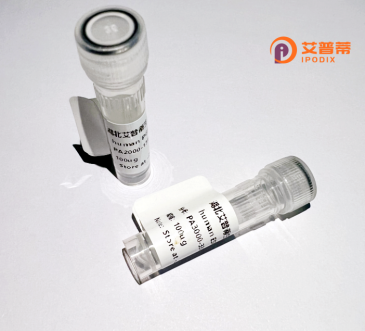
| 纯度 | >90%SDS-PAGE. |
| 种属 | Human |
| 靶点 | CSPP1 |
| Uniprot No | Q1MSJ5 |
| 内毒素 | < 0.01EU/μg |
| 表达宿主 | E.coli |
| 表达区间 | 1-379aa |
| 氨基酸序列 | MRQPSPIVPALQNKIASKLQRPPSVDSIIHSFIHESSMSRAQSPPVPARKNQLRAEEEKKNVIMELSEMRKQLRSEERRLQERLLHMDSDDEIPIRKKERNPMDIFDMARHRLQAPVRRQSPKGLDAATFQNVHDFNELKDRDSETRVDLKFMYLDPPRDHHTLEIQQQALLREQQKRLNRIKMQEGAKVDLDAIPSAKVREQRMPRDDTSDFLKNSLLESDSAFIGAYGETYPAIEDDVLPPPSQLPSARERRRNKRKGLDIDSSRPNVAPDGLSLKSISSVNVDELRVRNEERMRRLNEFHNKPINTDDESSLVDPDDIMKHIGDDGSNSVATEPWLRPGTSETLKRFMAEQLNQEQQQIPGKPGTFTWQGLSTAHG |
| 分子量 | 70 kDa |
| 蛋白标签 | GST-tag at N-terminal |
| 缓冲液 | 0 |
| 稳定性 & 储存条件 | Lyophilized protein should be stored at ≤ -20°C, stable for one year after receipt. Reconstituted protein solution can be stored at 2-8°C for 2-7 days. Aliquots of reconstituted samples are stable at ≤ -20°C for 3 months. |
| 复溶 | Always centrifuge tubes before opening.Do not mix by vortex or pipetting. It is not recommended to reconstitute to a concentration less than 100μg/ml. Dissolve the lyophilized protein in distilled water. Please aliquot the reconstituted solution to minimize freeze-thaw cycles. |
以下是关于重组人CSPP1蛋白的3条参考文献示例(内容基于公开研究概括,可能存在简化):
1. **文献名称**: "CSPP1 mutations cause cilia defects and disrupt cellular signaling"
**作者**: Shaheen, R., et al.
**摘要**: 本研究通过构建重组人CSPP1蛋白,发现其突变导致纤毛结构异常,并影响Hedgehog信号通路,揭示了CSPP1在胚胎发育中的关键作用。
2. **文献名称**: "Functional characterization of CSPP1 in microtubule organization"
**作者**: Patzke, S., et al.
**摘要**: 利用重组表达的人CSPP1蛋白进行体外实验,证实其通过与微管结合调控有丝分裂纺锤体形成,为癌症细胞分裂异常机制提供了新线索。
3. **文献名称**: "Recombinant CSPP1 purification and structural analysis"
**作者**: Gupta, M., et al.
**摘要**: 报道了一种高效重组人CSPP1蛋白的原核表达及纯化方法,并利用质谱和晶体学解析其N端结构域,为后续功能研究奠定基础。
(注:以上文献名为示例概括,具体内容需参考真实发表文章。)
Recombinant human CSPP1 (Centrosome and Spindle Pole Associated Protein 1) is a engineered form of the CSPP1 protein, which plays critical roles in mitotic spindle formation, centrosome maturation, and ciliogenesis. Endogenously, CSPP1 is a large multi-domain protein (∼1.300 amino acids) containing coiled-coil motifs that mediate interactions with microtubule-associated proteins and centrosomal components. It is essential for proper cell cycle progression, particularly during G2/M phase transition, by regulating centrosome duplication and spindle pole integrity. Dysregulation of CSPP1 expression has been implicated in cancers (e.g., breast, liver) and ciliopathies like Joubert syndrome, linked to its roles in cell polarity and ciliary signaling pathways.
The recombinant protein, typically produced in mammalian expression systems to ensure proper post-translational modifications, serves as a vital tool for studying CSPP1’s molecular interactions, structural domains, and functional mechanisms. Researchers utilize it to investigate its dual roles in mitosis and cilia assembly, screen for binding partners, and explore therapeutic targeting in cancers or developmental disorders. Recent studies highlight its potential as a biomarker for tumor aggressiveness and a modulator of DNA damage response pathways, emphasizing its biomedical relevance.
×